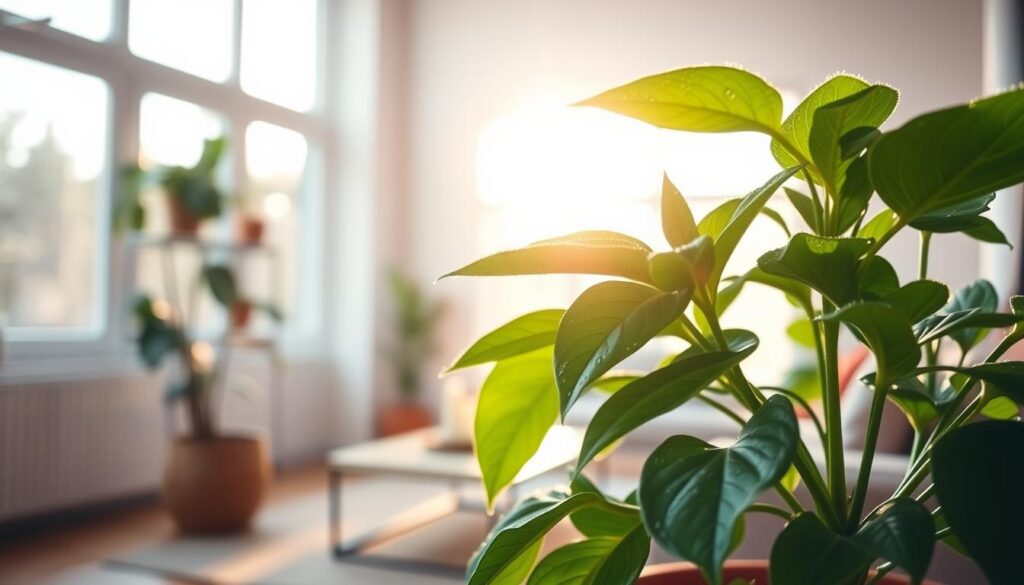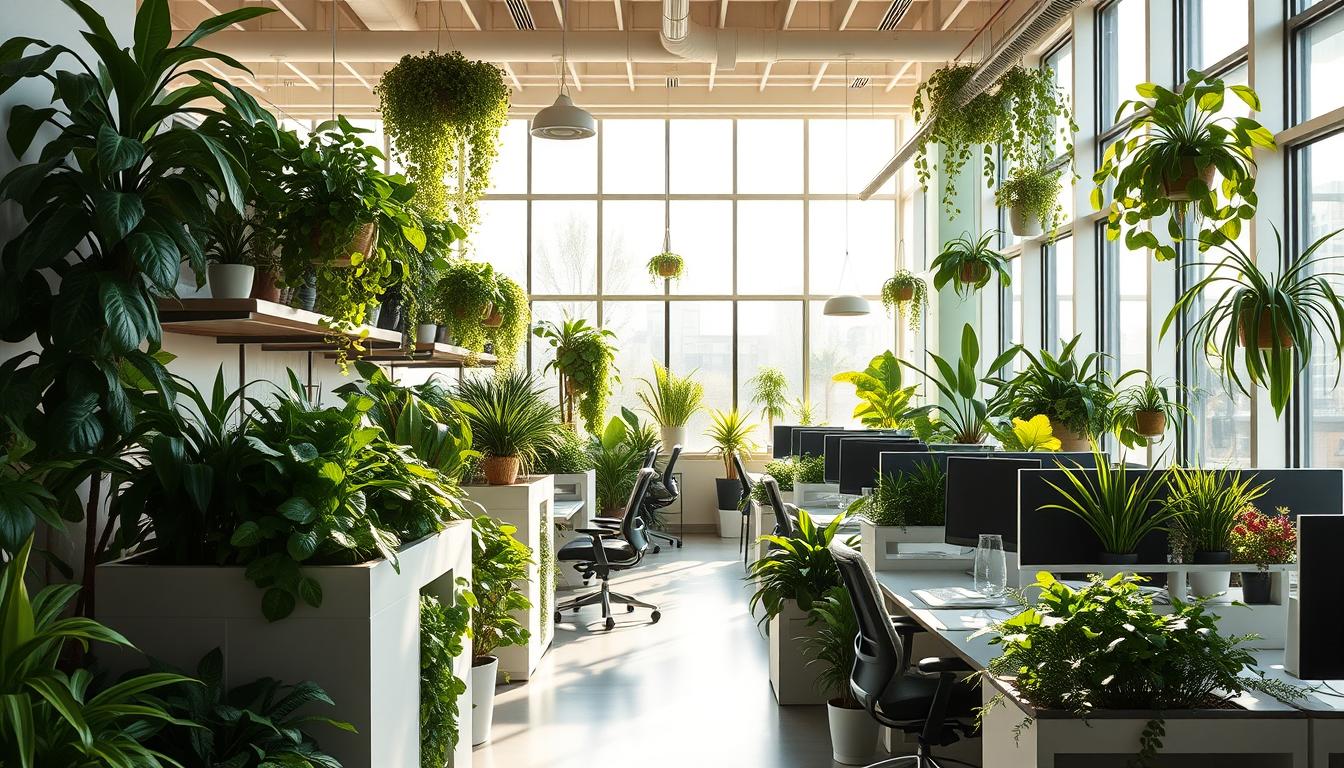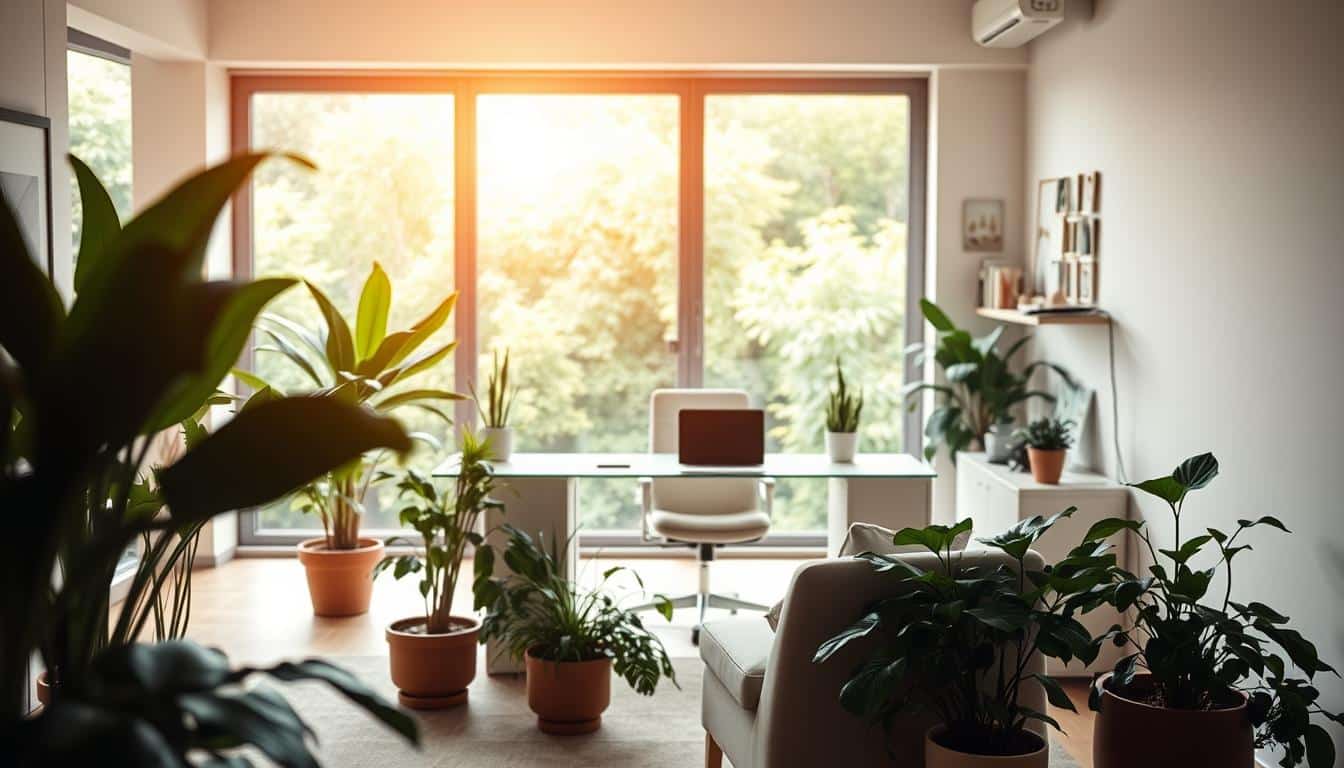This guide dives into how transpiration affects humidity balance. It’s crucial for anyone involved in indoor growing or controlled environment agriculture. By understanding this, you can enhance plant health and productivity. When plants release water vapor, they’re actually helping to maintain perfect growing conditions. This balance between plant water release and air moisture is essential for thriving indoor agriculture.
Introduction to Transpiration and Its Importance
Transpiration is a key process in plant life. It deeply impacts plants and the environment. By releasing water vapor from stomata, it lets plants take in carbon dioxide and cools them down.
This helps keep a plant’s inside temperature stable and moves nutrients around.
The Role of Transpiration in Plant Physiology
Transpiration plays a major role in plant health. It moves water through plants, helping with:
- Cooling the plant to avoid overheating.
- Moving important nutrients and minerals.
- Keeping turgor pressure for stability.
How Transpiration Affects Indoor Humidity Levels
Indoor air gets moister because of plant transpiration. More transpiration makes indoor air better for plants. This is key in greenhouses and indoor gardens to keep plants healthy.

Understanding Vapor Pressure Deficit (VPD)
Vapor Pressure Deficit (VPD) is key for plant health and growth. It shows the gap between the air’s moisture and how much it can hold at a certain temperature. Knowing about VPD helps us to make plants grow better as it affects important plant processes.
Definition and Significance of VPD
The vapor pressure deficit tells us if the air is dry or moist regarding water vapor. When VPD is high, it means the air is dry. This can make plants close their stomata to save water. This leads to less carbon dioxide intake and affects photosynthesis and plant health.
How VPD Influences Plant Growth
VPD impacts many parts of plant growth. If VPD is high, plants lose water faster. But if they lose too much moisture, it can cause stress and slow down their growth. Keeping VPD at the right level is essential for plants to grow well and produce good yields.
Explaining Transpiration-Based Humidity Balance
Transpiration-based humidity balance keeps the right moisture levels through plants’ natural transpiration. This balance is key for plants to grow well, especially indoors. Factors such as temperature and air quality affect how plants manage moisture, which helps them make food and transpire effectively.
What Is Transpiration-Based Humidity Balance?
This balance is about keeping moisture levels right, thanks to water vapor plants release during transpiration. It’s a big part of controlling humidity. By releasing moisture, plants help keep humidity between 60-80%. This level is important to keep stomata open for photosynthesis.
Factors That Affect Humidity in Indoor Environments
Several factors impact moisture in indoor spaces. They include:
- Temperature: Warmer air can make more water evaporate, changing humidity levels.
- Air Circulation: Moving air around helps spread moisture evenly, keeping humidity stable.
- Water Source: Having enough water for plants is key for indoor humidity.
Knowing these factors helps make a good environment for plants. This ensures they help maintain the right humidity.
How to Measure Transpiration and Humidity Levels
Knowing how to measure transpiration and humidity is key for plant care. It helps growers make sure plants are in the best environment. By using the correct tools for humidity, keeping track of the plant’s surroundings gets easier.
Tools and Methods for Measurement
Many tools help measure transpiration and humidity. You can use:
- Hygrometers for checking the moisture in the air.
- Thermometers to see air temperature, important for VPD numbers.
- Leaf wetness sensors for checking water on leaves.
- VPD calculators that use both temperature and humidity info.
Picking the right tools helps closely watch over plant conditions. This makes it possible to tweak care practices as needed.
Calculating VPD Using Temperature and Humidity Data
Figuring out VPD starts with simple steps. First, record the air’s heat and the moisture. The basic steps include:
- Finding the highest vapor pressure with the temperature.
- Using humidity info to get the actual vapor pressure.
- Taking the actual vapor pressure from the highest to get VPD.
Knowing how to do these calculations helps with managing plant sweating effectively. With accurate measures and the right tools, growers can make the perfect environment for their plants.
Best Practices for Maintaining Optimal Humidity
Keeping the right humidity is key for healthy and growing plants. Different methods help create the perfect setting. By improving how plants release water and checking humidity often, plants thrive with less stress.
Strategies for Enhancing Transpiration Rates
To better enhance transpiration, think about these methods:
- Use humidifiers to keep the air moist, especially when it’s dry.
- Bring in dehumidifiers if it’s too moist to avoid extra water.
- Make sure air moves well with fans to keep a steady environment.
- Watch how much you water to avoid too much, which slows down water release by plants.
- Make sure plants get the right amount of light they need.
- Keep temperatures in a good range since higher temperatures help plants release water better.
- Use programmable controllers for setting humidity and temperature automatically.
Monitoring and Adjusting Humidity Levels
It’s important to regularly check humidity levels. Keep these tips in mind:
- Hygrometers measure humidity accurately in your growing space.
- Have a regular schedule for reviewing humidity, and change your approach based on the weather.
- Watch how plants react to changes in humidity, and adjust water and air flow as needed.
- Keep track of humidity readings in a journal to spot trends and make better plans for controlling humidity.
Impact of Temperature on Transpiration
Temperature plays a crucial role in transpiration, affecting both VPD and humidity levels in growing spaces. Knowing how temperature influences these factors can help your plants stay healthy. It can also make water usage more efficient. Adjust the temperature correctly, and your plants will transpire at the best rates for their growth.
Temperature’s Role in VPD and Humidity
When the temperature goes up, so does the vapor pressure deficit (VPD). Warmer air holds more moisture, leading to a greater need for water vapor. This makes plants release more water to keep up with the humidity changes. Keeping the right balance of temperature, VPD, and humidity is crucial. Otherwise, plants might get stressed or dry out.
How to Adjust Temperature for Ideal Conditions
To get the best growth, you need the right temperature settings at different plant stages. Here are some ways to do that:
- Use thermostats or climate control to keep temperatures just right.
- Check on things like lighting and airflow that can change indoor temperatures.
- When it’s really sunny, use shades to keep plants from getting too hot.
- For young plants, heat mats help keep the soil warm when they start to grow.
Getting the temperature right affects VPD and humidity in big ways. When done right, growers can create the perfect conditions for their plants. This means they get enough water and nutrients to grow strong.
Transpiration-Based Humidity Balance in Different Growth Stages
It’s key to know what humidity plants need as they grow. Every growth stage has its own humidity needs for the best development. Here, we talk about what humidity is right for seedlings, the vegetative phase, and the flowering stage.
Humidity Needs for Seedlings and Clones
Seedlings do well in high humidity, around 70% RH. High humidity helps them grow strong roots and reduces the shock of moving them. Clones also need this level of humidity to root well and avoid drying out.
Optimal Conditions for Vegetative and Flowering Stages
When plants reach the vegetative stage, they need a bit less humidity, about 65% RH. This helps them grow well while keeping enough moisture. During flowering, humidity should drop to 40-50% RH. Low humidity at this stage prevents mold and helps plants breathe better, leading to healthier plants. Adjusting humidity right for each stage helps plants yield more and reduces stress.
Common Challenges and Solutions in Humidity Control
Getting humidity right is key for plant health. Both too much and too little moisture can cause problems. Each issue needs its own fix.
Diseases Related to High Humidity
High humidity can lead to plant diseases. Conditions like mold and mildew love high moisture, especially when plants are blooming. Here are ways to prevent that:
- Consistently monitoring humidity levels to avoid spikes.
- Improving ventilation throughout the growing area.
- Utilizing dehumidifiers to maintain an optimal moisture balance.
Tips for Managing Low Humidity Situations
Managing low humidity is also crucial. Without enough moisture, plants can’t sweat properly, causing stress. Here’s what you can do:
- Using humidifiers to introduce moisture into the air.
- Strategically watering plants to enhance humidity around roots.
- Optimizing environmental controls to maintain stable humidity levels.
Conclusion
Keeping the right humidity balance is key for healthy plants and good growth. Knowing how transpiration, vapor pressure deficit (VPD), and humidity work together helps growers. These steps make plants strong and fruitful.
When you understand these ideas, you can make smart choices for your plants. This leads to better yield and quality. Keeping the right humidity is a big part of plants’ health.
In closing, smart humidity control helps plants thrive and produce better. Remember, well-managed humidity takes your gardening to the next level.



